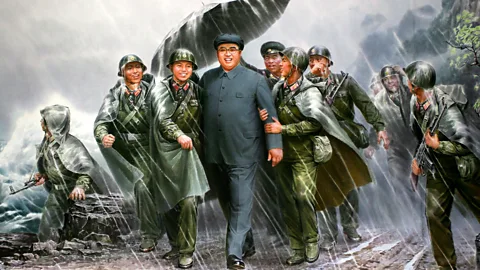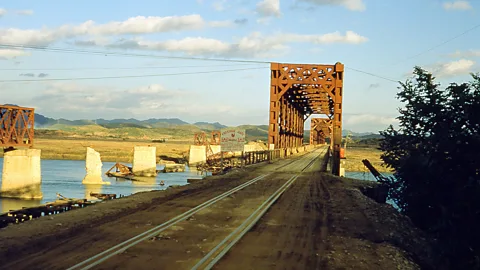The US defectors who became film stars in North Korea
 Alamy
AlamyUS soldier Travis King, who fled to North Korea in July, is in American custody after being expelled by Pyongyang. In 1965, another US soldier who crossed into the North ended up a film star there, writes Simon Fowler.
US soldier Travis King has been expelled from Pyongyang and is now in American custody, according to official reports. In recent years, a number of US citizens who illegally entered North Korea have been freed within six months – but that story was different for one US soldier in 1965. Charles Robert Jenkins abandoned his patrol in South Korea, and remained captive in the North for the following 39 years – becoming a film star there, along with three other US deserters.
This story originally ran in November 2015. Charles Jenkins died on 11 December 2017.
The 38th Parallel, which crudely splits the Korean peninsula in two, remains one of the most fortified places on Earth. In the 1960s, however, at the height of the Cold War, and with the Korean War just a decade in the past, it was the front line of the ideological conflict between the Communist-led North, also known as the Democratic People’s Republic of Korea (DPRK), and the US-backed South. The ironically named Demilitarized Zone (DMZ) was anything but, with landmines littering the division and regular skirmishes between the two forces.
In January 1965 at the height of tensions between North and South, US soldier Charles Robert Jenkins from North Carolina abandoned his patrol, took an unloaded M14 rifle and began walking across the DMZ. Spurred on by a fear of being enlisted to fight in the Vietnam War and a belief that deserting to the North would see him immediately deported back to the US, Jenkins began a perilous journey that would change his life forever.
 Smith Collection/Gado/Getty Images
Smith Collection/Gado/Getty ImagesOnce seized by the North Korean authorities Jenkins would remain captive in North Korea for the next 39 years. Since 1962 three other US soldiers in South Korea had deserted their posts and fled across the DMZ, and Jenkins would soon them sharing a single room under constant watch of the suspicious authorities. The life these four men led while in the DPRK would be dangerous at times but mostly filled with tedium while they adjusted to an alien life in the Hermit Kingdom few outsiders had experienced. The boredom and sense of desperation meant the Americans often went to dangerous lengths just to “have fun”: “stealing government property, or going on daredevil hikes, clinging to tiny ledges on the side of canyons,” recalled Jenkins in his 2009 memoir of his time in North Korea, The Reluctant Communist. These became the only outlets for the Americans “because in many ways we felt like we were already dead”.
Like all North Korean citizens, the Americans were assigned a ‘leader’ to ister regular sessions of self-criticism sessions generally to keep them in check. “These cruel bastards hated me and the other Americans so deeply that they refused to see us as human and enjoyed making our lives hell,” re Jenkins in his book. Beatings and psychological torture were commonplace, but the captives were always well fed, as they needed to appear fit, healthy and happy in the numerous propaganda leaflets on which they appeared that were dropped over the DMZ into South Korea. But though they faced interrogations and were confronted with hatred from the North Korean people, the most bizarre feature of their lives was how they all, at different times, became stars in North Korean movies.
Strangers in a strange land
Kim Il-sung’s government first came up with a propaganda role for James Joseph Dresnok, a towering man who deserted from the US military in May 1962, by having his voice boomed out over public address systems across the DMZ to the US soldiers on the other side. His messages described a utopian land where other soldiers could live gloriously if they followed his lead in crossing the line into North Korea.
 Chosun Art Film
Chosun Art FilmLike all communist governments, North Korea was well aware of the power of cinema as a propaganda tool. It was of particular interest in the 1970s to future DPRK leader Kim Jong-il, who at the time was vying for the respect of his father, Kim Il-sung. Kim Jong-il sent directors to study cinematic art abroad, he wrote a book on the importance of cinema in revolutionary struggle and he produced some of the most important propaganda movies of the time. He was instrumental in creating the most famous of the ‘Eternal Classics’ of North Korean cinema: The Flower Girl. Made in 1972 and allegedly based on a story written by Kim Il-sung, The Flower Girl is a melancholy exploration of evil landlords in the time shortly before North Korea was ‘liberated’ by the communist forces. An image of its star Hong Yong-hui appeared on North Korean banknotes until 2009 and Hong herself was only ever referred to by her character’s name in public.
In 1978 work began on what would become a 20-part epic called Unsung Heroes, a sprawling series of films which take a heavily North Korean view of the Korean War. Given that Western-looking actors were not exactly in abundance in North Korea at the time, each of the four deserters was required to act in the series of films portraying evil Western characters.
Jenkins played Dr Kelton, a US warmonger and capitalist whose goal in life was to keep the war going and benefit American arms manufacturers. They shaved the top of his head and caked on makeup for pantomime villain effect. Dresnok was Arthur, a commander of a brutal POW camp, and with his vast frame appeared looming and menacing. Larry Abshier was Carl, the subordinate to two evil Americans and Parrish was Lewis, a Northern Irish officer who detested the occupation of his country by the British. Parrish’s role did him the most favours: his Northern Irish character eventually deserts the British to the North Korean cause and this meant people in the streets of Pyongyang would treat him like a true communist hero.
An actor’s life
The pure hilarity of this arrangement was that four US soldiers, none of whom had graduated from high school, had gone from being reviled semi-prisoners to a ubiquitous presence in North Korea’s many cinemas. “After the first movie [Nameless Heroes], I would walk down the street and someone would yell, all excited and happy, ‘Kelton Bac-Sa [Dr Kelton]!’ and even regular North Koreans would ask for my autograph,” says Jenkins.
 Alamy
AlamyFor the remainder of his time in the DPRK, Jenkins was called upon to appear in films – right up to his final film in 2000 called Pueblo. That film was based on the 1968 incident when the US naval ship the USS Pueblo was attacked and captured by North Korean forces – the ship is still held on display as part of the Victorious Fatherland Liberation War Museum in Pyongyang – but there are dozens more films in which you can see a comically made up Dresnok or Jenkins appear if you look hard enough.
Dresnok, for the longevity of his stay in North Korea, became the stalwart of the movie scene. A key film appearance was that of a general in From 5pm to 5am. The story focuses on a squadron of North Korean soldiers during the Korean war who must scramble across dangerous terrain to cut off an American attack led by Dresnok’s evil general (with only the eponymous 12 hours in which to do it). With a commander whose health is failing him, a group of young but fiercely patriotic soldiers and a character who is perhaps the closest to comic relief ever seen in a North Korean film, the DPRK army manage to hold off the Yanks – who foolishly informed the press of their planned attack before going through with it.
 Alamy
AlamyNot only were the defectors required to appear in movies, but they were also required to feed Kim Jong-il’s cinema addiction. Notorious for having a vast archive of American movies (at a time when no-one else were able to view them in North Korea) the four Americans were often made to transcribe sections of movie dialogue from audio tapes. These transcripts would then be translated and added to the films as subtitles for Kim Jong-il’s private collection. These would usually be divided up into different sections so that the defectors weren’t able to discern context or even the title of the movie. Jenkins fondly recalls hearing part of Mary Poppins but having absolutely no idea what was going on.
The fates of Dresnok, Jenkins, Parrish and Abshier were mixed during their times in North Korea. Abshier died aged 40 of a heart attack in Pyongyang in 1983, while Parrish died of kidney failure in the 1990s. Jenkins married a Japanese woman who had been kidnapped in order to train North Korean spies in the Japanese language. The two were able to move to Japan in 2004 after an agreement which saw many Japanese kidnap victims returned and, after his eventual dishonourable discharge from the US military, he remained in the country until his death.
James Joseph Dresnok, however, continued to live in North Korea with the family he made there and expressed no intention to ever return to the US. He died in 2016. His life, and the complex relationship he had with Jenkins, is fantastically expressed in the documentary Crossing the Line. “I feel at home,” he told the film-makers. “I really feel at home. I wouldn’t trade it for nothin’.”
